QuestionI have been following all of the rules of training but can't get my dog to let
me know when he has to go. He doesn't seem to understand the difference
between outside to potty and outside to play. He usually goes back to back
in the morning. He poos and pees first thing when I get him out, then he
eats and will need to go again within the hour. The problem is, when I take
him out the second time, he wants to play and not poo. No matter how long I
stay out there (saying "potty", refusing to play so he gets it) he still holds it
and goes in the house the minute I take my eyes off him. When he realizes I
have found his accident, he knows he is wrong and immediately goes to his
crate (because that is where I put him after an accident). How can he be so
smart to know what happens after an accident but not smart enough to go on
command or at least find some signal to let me know he has to go. His signal
seems to be- wait until no one is looking and hide and do it. I don't even get
to say "no! no potting in the house!" and then send him to the crate. As soon
as he sees me lay eyes on the accident, he runs to the crate. Now, that is
smart! At one time, I would take him out and if he didn't go, I would crate
him again and come back every 30 to 45 min. to try again and would repeat
until I got the results. After that time, he seemed to get the concept and that
was when I figured out his schedule. He even went to the door a few arbitrary
times and sat and I thought, this is the signal! He was doing so well for about
2 weeks with only a few accidents here and there that I started giving him
more freedom. Well, all of a sudden, he started playing games, holding it
outside and going inside and I never saw the door signal again. It is almost
like he gets a kick out of waiting so he can hide and do it. I praise him when
he goes outside and give him treats, I say potty Smokie and good job every
time when he goes. He never goes in his crate. He can hold for 4 hours
(which is only done at night) which is why I don't understand why as much as
we take him out, he will still go in the house by choice. Am I crazy? Or is
this just part of the process? Does it take longer than it would seem and am I
taking it too personally or is he giving me the flux? He learned to sit in 2
days, 10 treats later. He stops whatever he is doing when he hears "no". How
long does it take to get potty training down? Just for a little back ground, he
is 15 weeks old, never used potty pads, I have the same routine from crate to
door to go potty, I keep his area clean, I stay outside with him the whole time
saying potty and praising with love and treats, when he makes an accident, I
use to take him outside first and say "potty here" then take him to his crate,
now he just runs to his crate, I thoroughly clean accidents in the house (by
the way, he does not have a special spot inside, he will go wherever he is not
seen). I feel like I am missing the training of a signal. My girlfriends adult
poodle will pee or poo in the house if he gets mad at you. I honestly don't
think that my puppy is giving me attitude. I really think the missing link is
the signal to go or needing to go on command. Since he wants to play and
can hold it, I think he chooses to do so, so he can play, then when we come
back in and in 10 or 15 min. later, he doesn't have a signal to say, "ok, I am
ready to go back out and do my business this time". Is the signal something I
teach him or he teaches me? Should I try the bell or bells on the door? How
do I get him to go on command? I don't use a leash when we go out, should
I? Thanks for reading all of my rambling and taking the time to respond.
AnswerI have never done bells on the door, but it works for many people. I think what you need to do is not let him out of your sight. When you are around you need to keep a close eye on the dog. Use closed doors or gates to keep it in the same room as you are, and perhaps as I do, a short chain fastened to the computer desk. If you catch it in the act, give it a sharp ''Ah, ah, ah!'' and take it out. When you can't watch it, crate it.
You also need to recognize when he needs to go, and take him out then. Watch him, not the clock. It needs to go out the first thing in the morning, after eating, drinking, and sleeping. If it quits playing, and starts running around sniffing, it is looking for a place to go. Take it out quickly. Once out, if he doesn't do anything, keep him active. They can't walk and hold it very long. Whoever said don't play is wrong. Much of the advice on the web on housebreaking smells just like your house will if you follow it. If you take the puppy out when it doesn't have to go and just let it sit there, it has no idea what is happening.
By the time most dogs are about 3 months old, they have figured out that if they go to the door and stand, you will let them out. The praise slowly shifts to going to the door. If your dog doesn't figure this out, try praising it and putting it out if it even gets near the door.
If you have a fenced yard, no need for a leash.
More details if you need them:
Much of housebreaking is not training the puppy, but making it easier for your puppy, you, and your carpet while its body to catches up to its instincts. At around 8 weeks when the puppy goes to its new home, the time from when it realizes it has to go, and when it can't wait any longer is a matter of seconds. Only time will fix that. You can hardly be expected to be attentive enough to avoid all accidents. There is no sense punishing the puppy for your inattention. It is not fair to punish you either, but you still have to clean it up if you didn't have the puppy outside in time.
Housebreaking starts before you get home with the new puppy. If you don't have a crate, buy one. I prefer the more enclosed, den like plastic ones. Skip the bedding. At first it gets wet, and later it can be chewed into choking hazards. A wire grid in the bottom will help keep the puppy up out of accidents at first. They are available with the crates, but expensive and hard to find. A piece of closely spaced wire closet shelving from a home supply place is cheaper. I am now using a plastic vegetable bin with plenty of holes drilled in the bottom. It helps block off part of the crate for the smaller puppy. If you already have a metal crate, covering it may help. Just make sure you use something the puppy can't pull in and chew. Dogs that start out in crates as little puppies, accept them very well. Never leave an unattended puppy loose in the house. If nobody can watch it, put it in the crate. I suggest letting the dog have its crate all its life. A crate needs to be just big enough for a dog to stretch out in.
Choose a command and spot you want it to use. The less accessible to strays, the less chance of serious disease. If it is a female, choosing a non grassy spot will avoid brown spots later. When you bring it home, take it to the spot and give it the command in a firm, but friendly voice. Keep repeating the command and let the puppy sniff around. If it does anything, praise it. Really let it know what a good dog it is and how much you love it, and maybe a treat. Note, being out there not only means you can praise it, but it also keeps it from being snatched by a hawk. If it doesn't go, take it inside and give it a drink and any meals scheduled. A young puppy will need to go out immediately afterward. Go to the spot and follow the above routine. Praising it if it goes is extremely important. If it doesn't go, take it back inside and put it in its crate and try again soon. Do not let it loose in the house until it does go.
At first it is your responsibility to know and take the puppy out when it needs to go. It needs to go out the first thing in the morning, after eating, drinking, and sleeping. If it quits playing, and starts running around sniffing, it is looking for a place to go. Take it out quickly. You will just have to be what I call puppy broke until it is a little older. How successful you are depends on how attentive you are.
By the time most dogs are about 3 months old, they have figured out that if they go to the door and stand, you will let them out. The praise slowly shifts to going to the door. Some people hang a bell there for the dog to paw. If your dog doesn't figure this out, try praising it and putting it out if it even gets near the door. When you catch it in the act, give it a sharp ''Ah, ah, ah!'' and take it out. Clean up accidents promptly. I mostly keep the little puppies out of the carpeted rooms. Still I need the can of carpet foam sometimes. First blot up all the urine you can with a dry towel. Keep moving it and stepping on it until a fresh area stays dry. A couple big putty knives work well on bowel movements. Just slide one under it while holding it with the other. This gets it up with a minimum of pushing it down into the carpet. This works with even relatively soft ones, vomit, dirt from over turned house plants, or anything else from solids to thick liquids. Finish up with a good shot of carpet foam. Note, do not let the puppy lick up the carpet foam. Once the dog is reliably housebroken, your carpet may need a good steam cleaning.
Many people strongly strongly push cleaning up all evidence of past accidents. I am slower to suggest that. Dogs will return to the same spot if they can find it. When you see one sniffing the spot, that is your clue to run it out.

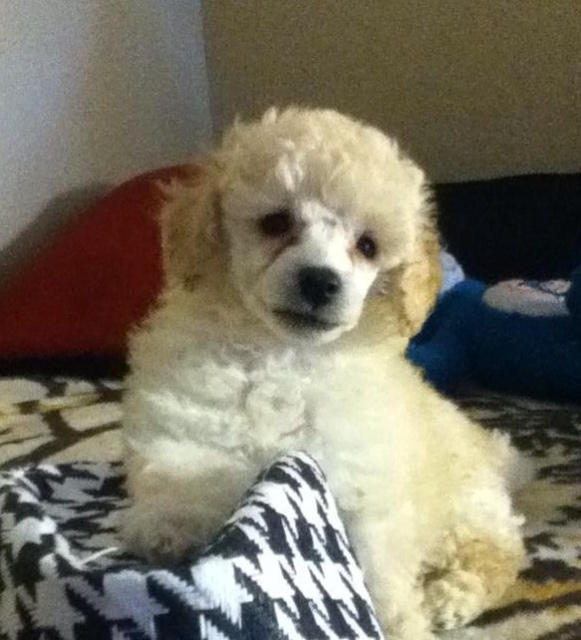 Toy poodle color
Question
CHARLIE
I bought a toy poodle puppy. &n
Toy poodle color
Question
CHARLIE
I bought a toy poodle puppy. &n
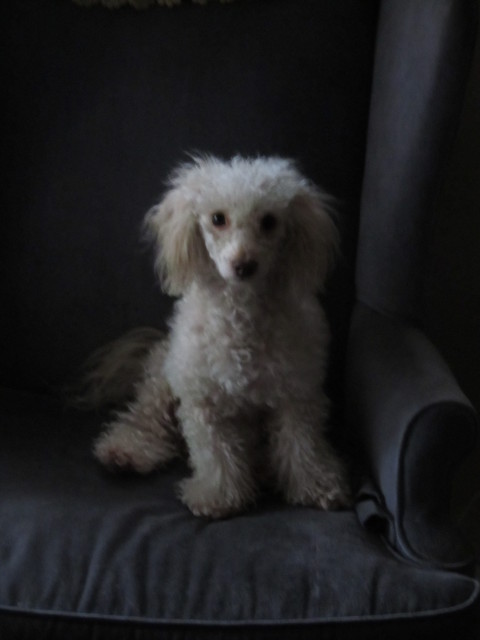 Poodle short hair on his head
Question
Picasso 18 months
My 18 month old rescued pood
Poodle short hair on his head
Question
Picasso 18 months
My 18 month old rescued pood
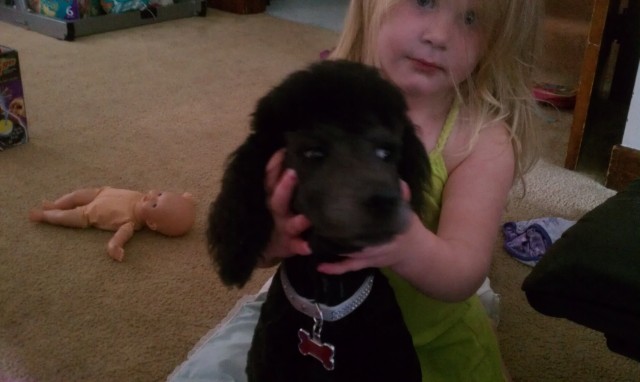 silver or blue puppy
Question
gretchen blue or silve
Hi ,
I bought a black (
silver or blue puppy
Question
gretchen blue or silve
Hi ,
I bought a black (
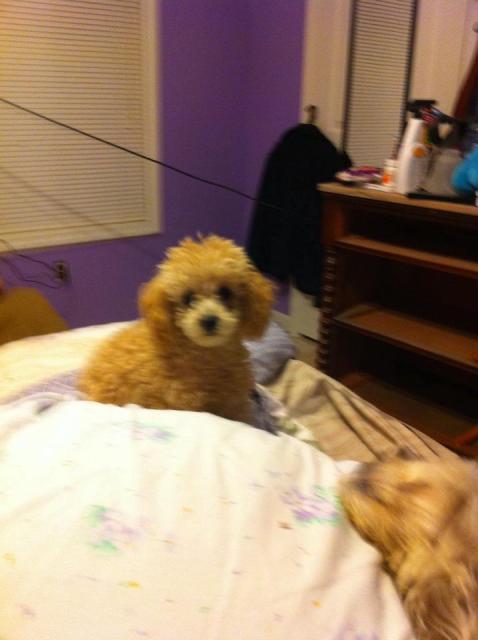 hey kim! my pups are grown but i have a ?
Questionrascal
QUESTION: Hey kim, my puppies ha
hey kim! my pups are grown but i have a ?
Questionrascal
QUESTION: Hey kim, my puppies ha
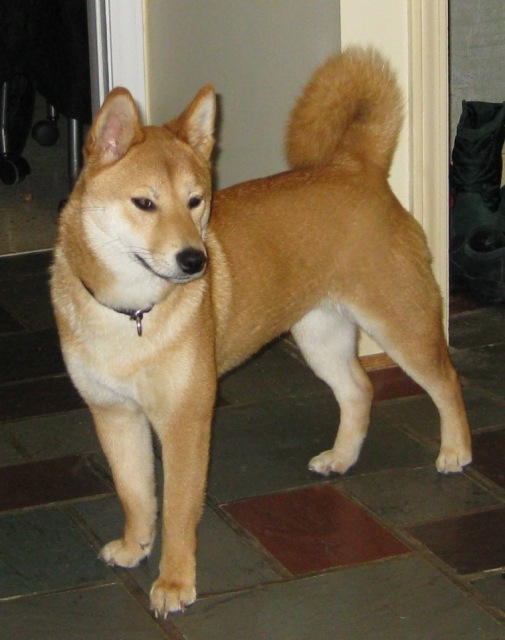 Rescued Shiba with ISSUES
Question
Shredder
Hi, I consider myself an experienced
Rescued Shiba with ISSUES
Question
Shredder
Hi, I consider myself an experienced